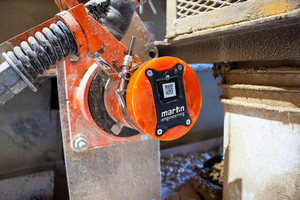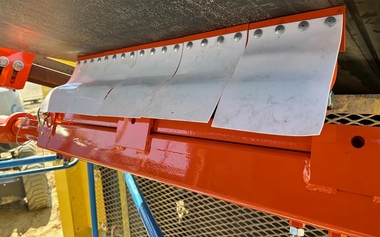Servicing the conveyor cleaning blade
It may sound simple, but tuning a belt cleaning system to operate safely and effectively requires a significant amount of knowledge and skill. Some manufacturers offer factory-trained personnel and replacement parts to provide expert maintenance for optimal performance and longer component life.
Safe service
Regardless of the application, experts recommend two or more cleaners per discharge (primary, secondary, tertiary). In addition to providing better cleaning with multiple cleaners, redundancy can extend the service window. However, the blade composition must match the needs of the application.
A trained service technician understands the hazards associated with maintaining belt cleaners. Maintenance includes tensioner adjustments, removing buildup on the blade, cleaning spillage under the system, and replacing the worn blade. With only a few exceptions, all cleaner maintenance must be conducted following lockout, tagout, blockout, and testout (LO/TO/BO/TO) procedures.
Reputable manufacturers design their cleaners and tensioners to achieve optimal cleaning performance relative to blade wear. It may seem counterintuitive, but if the cleaner isn’t performing well, increasing cleaning pressure can actually exacerbate the problem. Maintenance personnel must understand these phenomena and know how and when to adjust each style of cleaner, adjusting blade materials and cleaning pressures for different seasons or ROM (run of mine) conditions.
One primary cleaner design called Cleanscrape® requires only initial tensioning and virtually no maintenance after installation. It features a matrix of tungsten carbide scrapers installed diagonally to create a 3-dimensional curve around the head pulley and typically provides up to 4 times the service life of urethane cleaners.
Inspection and Monitoring
Monitoring systems can track component wear and notify the service technician and/or operations personnel via Wi-Fi or cellular service about upcoming service needs. The technology will also send an alert through a mobile app and computer dashboard in the event of any adverse conditions. This relieves staff from having to physically inspect multiple systems on a regular basis, freeing them to perform other essential tasks.
Conclusion
It is crucial to choose a supplier with trained and experienced service technicians who understand the equipment and safety procedures and can respond quickly to customer needs. Automated monitoring equipment alleviates some of the issues with blade wear and provides data and alerts when blades require servicing. Proactive maintenance reduces labor costs and enhances safety. Considering a managed service program can boost productivity and lower the cost of operation.
Autor:
Chris Schmelzer, Director of Conveyor Products
Martin Engineering, Neponset/USA
Literature
[1] Findings from a Study of Belt Cleaner Blades and Belting. R. Todd Swinderman, SME Coal Handling and Storage Conference and Exhibition St Louis, November 2011









